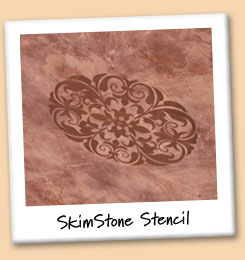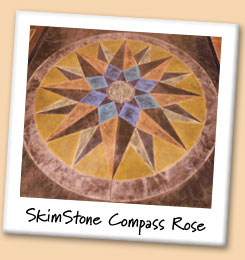You'll find an easy to use coverage calculator at www.skimstone.com. Just enter the information for your project and the calculator will determine the amount of product you need. There's also a chart to help with substrate ratings, a color card, and a Quick Reference Guide.
Do I have to use a trowel to apply SkimStone?It is the angle of the trowel, and the pressure applied, that result in the textured appearance unique to SkimStone. The trowel also helps to ensure that the SkimStone goes down in very thin coats. Other tools can certainly be used in applying SkimStone, such as brushes, rollers, or sponges. The final appearance and textures will vary with each application technique, as will coverage rates.
What should I use to fill holes, chips & cracks before applying SkimStone?Some people prefer leaving small cracks and incorporating them into the overall design. However, if you're not one of those people, you can use the SkimStone to fill small imperfections in the floor by mixing it to a consistency of patching compound. Use a putty knife to fill the holes or cracks and allow to dry for 24 hours before applying the first coat of SkimStone.
Note: Do not fill in expansion joints with SkimStone. We recommend taping off expansion joints with painter's tape while applying the SkimStone. Then remove the tape and touch up the joints by brushing on SkimStone to achieve the proper color before applying the Protective Sealer.
Each SkimStone coat goes down paper-thin. A common misconception is that since SkimStone is a hybridized cement product, it should be applied in thick coats. It is the process of applying 2-3 very thin coats with a trowel that creates the textured appearance unique to SkimStone. Holding the trowel at an angle and applying pressure will help ensure even, thin coats. The total application of 3 coats of SkimStone and 4-5 coats of Protective Sealer will be less than 1/32" on a concrete floor!
How long does it take SkimStone to dry and cure?Each coat of SkimStone takes between 30 minutes to 2 hours to dry, depending on the temperature and humidity. The final coat of SkimStone must be allowed to dry 8 hours prior to applying the first coat of sealer. Drying time for each coat of Protective Sealer also ranges from 30 minutes to 2 hours. Full hardness of the SkimStone surface is achieved after 7-10 days.
Note: Using SkimStone in direct sunlight can accelerate the dry time, making it difficult to spread in a large area. Shading the area with tarps or scheduling the work to coincide with the shade is helpful.
SkimStone is a decorative finish for concrete and may be used for both interior and exterior applications. The only difference between interior and exterior use is that we recommend using no more than two thin coats of SkimStone Protective Sealer for exterior applications. This will help to "pop", or develop, the color but still allow the surface to breathe and prevent moisture from being trapped under the Sealer.
Can SkimStone be used over painted or sealed concrete?Previously sealed or painted concrete must be taken to bare concrete by grinding or shot blasting. A diamond grinder is the preferred method. This will promote maximum adhesion of SkimStone to the concrete. After removing the old coatings make sure the surface is clean, then pour approximately 1 tablespoon of water on the surface. If the concrete changes color and absorbs the water, it will accept SkimStone.
Can I apply SkimStone on a floor other than concrete, such as tile, vinyl, or wood?SkimStone is formulated for application over concrete floors. Good adhesion has been achieved over a wide variety of materials but bare concrete is the only recommended substrate for SkimStone floors.
Can I use SkimStone around my pool?We have completed exposure tests with SkimStone using a spa and hot tub sanitizer containing a chlorine concentrate. Our results indicate that exposure will cause some of the SkimStone colors to fade over time. Consequently, we do not recommend using SkimStone as a decorative finish for chemically treated pools.
Note: When using SkimStone on pool surrounds, we recommend that no more than two coats of Protective Sealer be applied. This will allow the surface to breathe and prevent moisture from being trapped under the Sealer.
We've done a series of Hot Tire Pick-Up tests in our lab with excellent results, i.e., no pick-up. However, the SkimStone Protective Sealer (a pure waterborne urethane coating) can be penetrated by anti-freeze and some automotive fluids so drips and spills must be promptly wiped up. Garage floors are typically very smooth and sealed to prevent dusting, which makes them easier to keep clean. We recommend preparing the surface by mechanical grinding (a diamond grinder is best) or shot blasting to promote maximum adhesion.
SkimStone is not suitable for asphalt driveways. It can be used on concrete driveways but may not be the best or most economical choice because the first coat could act as a fill coat and require that you use a great deal more material. If you do use it on your driveway, apply no more than two coats of Protective Sealer to allow the surface to breathe and prevent moisture from being trapped under the SkimStone.
Can I refinish my laminate counter top with SkimStone?SkimStone can be used on laminate counter tops that have first been coated with SkimStone Bonding Primer. The Bonding Primer provides inter-coat adhesion plus a textured surface to promote high-adhesion with the SkimStone topcoat.
Can SkimStone be applied to walls?While formulated specifically for concrete, SkimStone will work on painted or unpainted walls. A finished look similar to Venetian Plaster can be achieved without all the burnishing. However, don't forget that you're working with a cement based product. When applying SkimStone to a vertical surface it can be quite messy - and special care must be taken to protect your eyes from accidental contact with the material. Additionally, the use of metal lath or fiberglass cloth may be required to stabilize SkimStone when applied to vertical or curved surfaces. It should also be noted that SkimStone is a decorative finishing system and is not intended for use as a structural element.
Can SkimStone be used around my fireplace?SkimStone can be used on fireplace surrounds and hearths, essentially anywhere it would be okay to use latex house paint. The radiant heat from the fireplace will not affect the SkimStone or the Protective Sealer. However, SkimStone nor Protective Sealer are heat resistant and are not acceptable anywhere high temperatures or direct flame will be common.v
Light foot traffic is permitted for the first 24 hours after the final coat of Protective Sealer has dried. Use floors with care during the first 7 to 10 days. Avoid sliding furniture across the surface or covering with rugs during this time. The use of felt pads or protectors on furniture legs will help prevent scratch marks from appearing.
Can SkimStone withstand freezing temperatures and thawing?Our site testing has indicated that SkimStone, when applied as recommended, is unaffected by freezing temperatures or temperature changes. However, SkimStone will not prevent your concrete slab from cracking, and cracks in the slab may telegraph through the SkimStone.
How Slippery is SkimStone?A SkimStone surface sealed with 4-5 coats of Protective Sealer is about as slippery as a finished hardwood floor. An unsealed surface will be similar to that of unsealed concrete.
How durable is SkimStone?SkimStone is a hybridized Portland cement, so it is very durable. Over time, you may notice wear areas developing in the seal coat. A periodic reapplication of SkimStone Protective Sealer will keep your floor beautiful and protected. In light commercial or high traffic areas, a final application of wax or polish may be used as the sacrificial wear coat.
Any concerns regarding exterior applications of SkimStone in sub-tropical areas?It is imperative that SkimStone be allowed to breathe when applied outdoors. For best results when using SkimStone in climates with high rainfall combined with hot temperatures and direct sunlight, we recommend using no more than two coats of the Protective Sealer. This will ensure that the surface can readily absorb and dissipate moisture.
SkimStone is sold through dealers across the US and Canada. If you need help locating a dealer in your area, call us at 206-914-9104 or email us at info@artisanfinishes.com.
How much does SkimStone cost?When applied over a very smooth concrete floor, the material cost is very economical compared to other types of coatings. Over concrete that is more textured, weathered or damaged, the material cost will increase because more product will be used during the first coat to fill imperfections on the surface.


